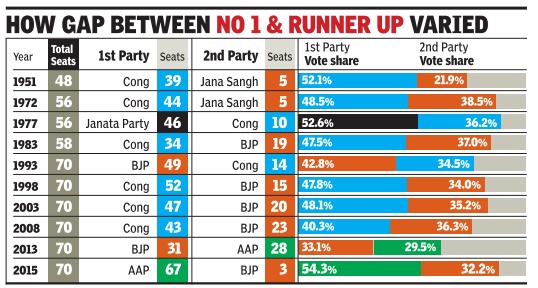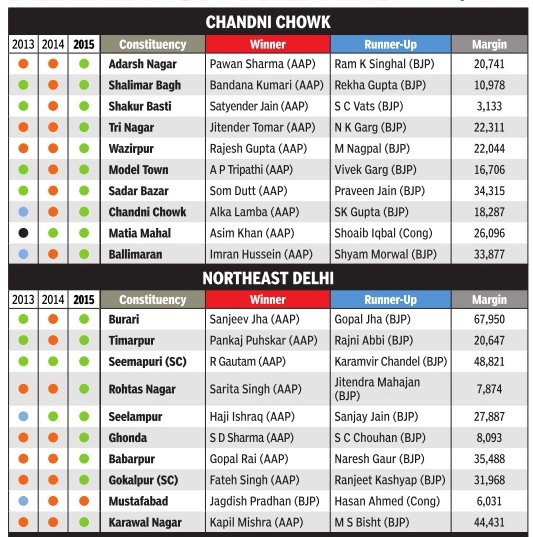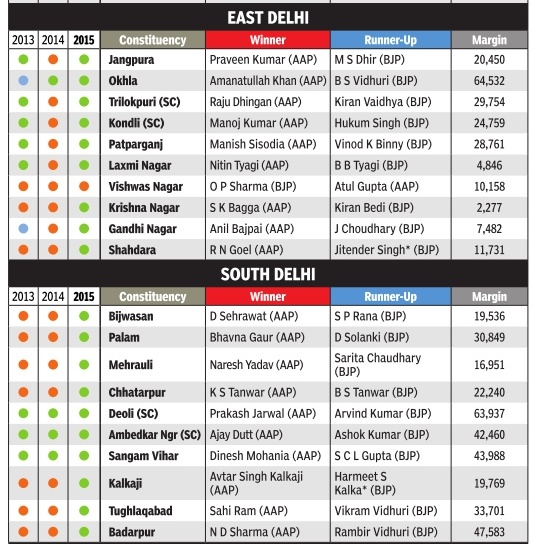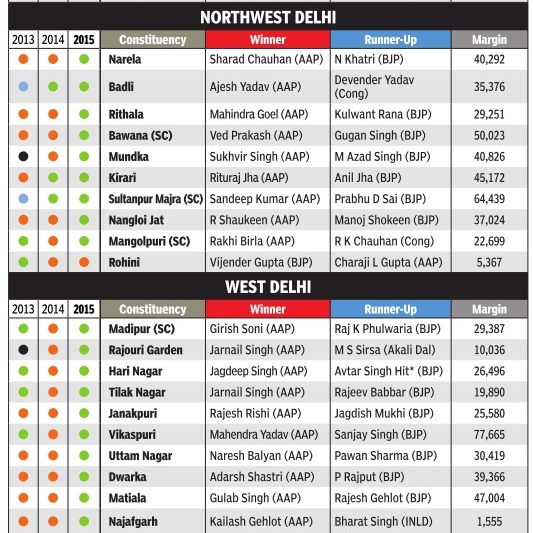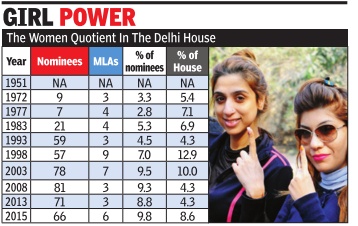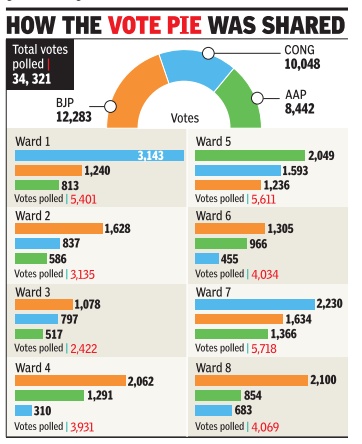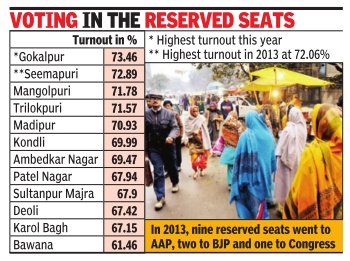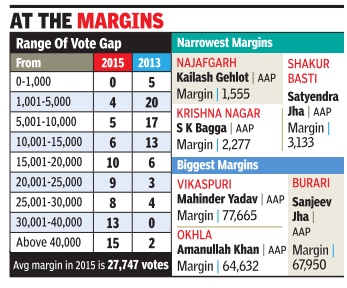Delhi: Assembly elections,2015
This is a collection of articles archived for the excellence of their content. |
Contents |
Delhi cantonment board elections: 2015
Jan 13 2015
Risha Chitlangia
BJP's strong performance in the Delhi Cantonment Board poll and a sharp decline in Aam Aadmi Party votes is a morale booster for the party ahead of the much more challenging task of winning the assembly polls scheduled for February 7. With BJP-backed candidates winning five out of eight wards, the party is keen to read the result as an indication of polls winds in the capital with Prime Minister Narendra Modi having launched the saffron campaign with a rally on Saturday , a day before polling for the cantonment board.
Though the board election is modest in terms of the electorate and BJP won a seat less than earlier, there are reasons for satisfaction. AAP's failure to revive its fortunes after scoring a blank in the LS election and Congress's relatively better performance plays to BJP's advantage.
The increase in Congress's vote share comes at AAP's expense and the trend augurs well for BJP that would prefer a three-way fight in assembly polls rather than a more direct one-to-one face off with AAP and its convenor Arvind Kejriwal.
The results also indicate that the party continues to en joy middle class support-the can tonment area has a sizable population of this segment while Congress neutralized AAP's impact with Kejriwal's outfit registering a 15% dip in its votes, down to 25% from 40% in the assembly elections. “This has once again proved that BJP is the first choice of Delhiites. The voters of the cantonment board have shown that they do not believe in fractured mandate,“ said Satish Upadhyay , Delhi BJP chief. Though BJP had staged a recovery in the LS election, the results were read as the result of a Modi wave and the party was aware that in 2013 AAP's commando Surender Singh defeated four-time BJP strongman Karan Singh Tanwar by 300-odd votes. AAP finished third in four wards and most of its candidates lost by a large margin.
With the party having tak en a calculated gamble in not projecting a CM candidate in a highly urbanized state, evidence that Modi's appeal with the middle class and “urban“ villages has not waned will increase the confidence levels in the BJP and embolden party chief Amit Shah to adopt a tough yardstick in selecting Assembly candidates.
Despite being routed by AAP and BJP in 2013, Congress managed to retain two wards and pushed AAP to third position. This helps Congress argue that it is the alternate to BJP and that AAP is fading. Congress has got 10,048 votes to AAP's 8,442 votes but the difference helped Congress climb the rankings. BJP, which lost in three wards, finished second in two.
AAP finished third in four wards and most of its candidates lost by a large margin.But AAP members do not see this as reflecting the broader mood in the city . “This doesn't reflect the public mood. This is a small area. Moreover, we are contesting for the first time. We have managed to win in BJP's stronghold,“ said Surender Singh.
The result has revived Congress' hope that it will not be washed out again. “The gap in the vote share between BJP and AAP, and Congress emerging as second shows the ground situation is changing.It is not a two-way contest,“ said Arvinder Singh, DPCC chief.
2015: The campaign
Delhi assembly elections 2015: An acerbic campaign where no one was spared
PTI | Feb 6, 2015 PTI
A look-back at the Delhi poll campaign reflects how the war of words among different contestants and parties unfolded one of the fiercest and bitter election narratives of recent times.
Prime Minister Narendra Modi set the tone for the election battle by making a veiled reference to Arvind Kejriwal as an "anarchist" in the first BJP rally at Ramlila Maidan.
"We need development here, not anarchy. They are good at dharnas. We are good at running government," the Prime Minister said.
After Kiran Bedi decided to make her political debut by joining the BJP, Congress came down hard on her terming it as "gross political opportunism".
Arvind Kejriwal welcomed his former comrades in arms with a politically correct tweet saying "I have been fond of Kiran Bediji. I always tried to convince her that she should join politics. I am happy she did it today".
However, the AAP niceties disappeared as soon as Shazia Ilmi followed Bedi and the verbal slugfest broke loose.
Ashutosh called Bedi's move of joining BJP as an "iconic political somersault and opportunism on her behalf".
The party dug out old tweets of both the former India Against Corruption members, the ones in which they had previously criticized Narendra Modi.
"One day, Namo (Narendra Modi) will have to respond with clarity about riot massacre," a tweet posted by Bedi on March 16, 2013.
AAP went on to say that Bedi was "parachuted" into BJP which can make her a "scapegoat" in case the party lost the elections.
"Bedi is a scapegoat ... Vijay Goel, Satish Upadhyay, Harsh Vardhan are plotting against her," Kejriwal said.
Kiran Bedi hit out at Kejriwal terming him as a "toxic" influence and his twitter account "polluting".
"His company is toxic. I felt it to an extent even when I was with him, but we had a common goal that the country must rid itself of scams and corruption," Bedi said.
In a tweet, she said, "I blocked him (Kejriwal) 15 months back when he called himself an anarchist. He was spreading negativity. Didn't want my four million followers to see negativity ... it was a polluting account".
As the controversy surrounding AAP's election funding erupted, a new saga of mudslinging was witnessed.
Shazia Ilmi dubbed the Rs 2 crore donation to the Aam Admi Party as "hawala at midnight".
"They talk about an internal Lokpal. But no one worries of checking donations of Rs 2 crore. Kejriwal is hiding behind a false image of honesty and trying to fool people," Ilmi said.
Amit Shah also attacked AAP extensively on the controversy at the election rallies with catchy alliteration.
"Kali raat me kala dhan lene wali party kali rajneeti hi kar sakti hai (Party which takes black money in the darkness of the night can only indulge in black politics)," Shah said at a rally on February 4.
A day later at another rally, he said, "Kali raat me aane wala dhan kala dhan hi hota hai (money which comes in the dark of the night is black money)".
Miffed at not getting an invitation to watch the Republic Day parade, Kejriwal also created a furore and Bedi came down heavily on the AAP chief.
"I think he is playing sob sob. I think he must grow up. Invitations come not when you desire. They come by something else but they are never demanded, they come by rules and regulations, by protocols whatever it is," Bedi said. AAP accused that the cameras were focusing a little more on Bedi who was seated in the front rows watching the parade.
"It is for the country to see what is being done. How a sacred occasion like the Republic Day is being politicized. the camera was focusing a little extra on her," senior AAP leader Yogendra Yadav said.
The Prime Minister switched into election gear after hosting President Obama on Republic Day and accused AAP of "backstabbing" Delhi voters.
"The very people whom you voted for last time stabbed in your back. They shattered your dreams and destroyed Delhi. You gave them a befitting punishment in Lok Sabha polls. People do not repeat their mistakes again and again," Modi said at an election rally.
Highest voter turnout of 73.46%; Development issue still unaddressed Gokalpur has never repeated MLAs
Ambika Pandit
Feb 09 2015
Development is yet to touch most lives in the densely populated constituency of Gokalpur, which is a cluster of 45 unauthorized colonies and a resettlement colony. However, this seat, one of the 12 reserved SC constituencies, recorded the highest voter turnout of 73.46%. Of the 1.94 lakh voters, about 90,000 (46%) are from scheduled sub-castes like Khatik, Mallaha, Koli and Valmiki and their votes decide the winner.
It is not just the highest turnout that sets this constituency apart, but also the fact that the constituents here have voted for change every election and not repeated an MLA.
None of its elected representatives in the past 22 years have managed to retain their seat. In December 2013 polls, Gokalpur was one of the top performers registering a voter turnout of 70.88%. Nine of 12 reserved constituencies rejected Congress and chose AAP, but this was one of the two seats which chose a BJP candidate.
Many here are not surprised by the high turnout as this election was a high pro file one considering the fact that three ex-MLAs and the daughter of an ex-MLA were in the fray.
Intense mobilization by all candidates in the assembly with a dominant Dalit vote base seems to have brought out more voters than ever before. Also, residents here are restless with pressing development issues remaining unaddressed for decades.
Residents here feel the pinch of not having a government hospital to cater to the needs of the poor and low income group families.
Schools are few and sewers have only started coming to some areas. The vote this time, thus, is probably seen as yet another attempt by residents to bring their plight into focus.
The February 10 verdict will be a test for the entire heavyweight line-up, which includes AAP’s Fateh Singh, who was BJP’s MLA from 1993 to 1998, BSP’s former MLA Surender Kumar, and Ranjeet Kashyap who was the 2013 legislator from BJP.
Congress, which hasn’t won Gokalpur since 2003, fielded Rinku, municipal councillor from Nand Nagri ward of the neighbouring Seemapuri assembly constituency.
Even though Rinku is not a household name in Delhi politics, she is no stranger to Gokalpur being Roop Chand’s daughter.
Chand, the MLA from Gokalpur between 1998 and 2003, wrote the book, ‘Dr BR Ambedkar: Neither a Freedom Fighter nor the Architect of the Constitution’, which turned many voters and Dalit groups against him. But this time Congress fielded her in the assembly election dismissing the controversy as a non-issue and projecting her as an honest and the right choice for the seat.

Aam Aadmi Party: a comeback
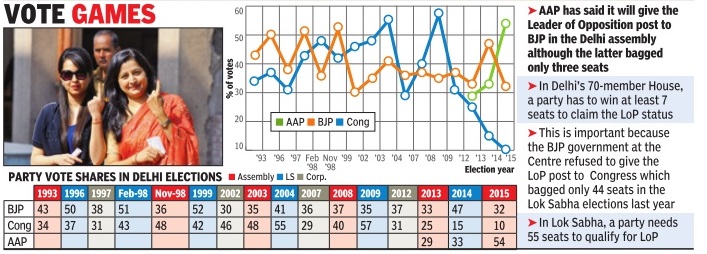
Feb 11 2015
Vibrant campaign connected with every caste, class
For the second time, Aam Aadmi Party has shown it does not need a long runway to take off, and what gives it lift is a massive army of dedicated workers that's always on the ground. In 2013, the party made a stellar electoral debut al though it was not in the race till September. This time also, it galvanized only in Decem ber. But after that it didn't lose focus although there was no certainty over election dates. While AAP's rallies and jan sabhas started formally on December 1, its teams had al ready started campaigning from door to door. The middle class seemed disenchanted with the party after the Lok Sabha polls, but mohalla sabhas by its 27 MLAs t to discuss the utiliza tion of funds helped it regain ground. Suresh Garg, a resident of Malviya Nagar, said people were im pressed by AAP's commit ment to `swaraj'. “ AAP had promised to hold such sabhas but we stopped taking it seri ously after its government re signed. However, regular con sultations by its MLAs restored our faith.“
AAP declared its 70 candi dates by the first week of Janu ary, so they campaigned hard for much longer. Some of its candidates were first-timers and the head start helped them become visible.
AAP's style of campaigning, marked by youthful energy, also made it stand out. A team of young, dynamic and extremely dedicated volunteers worked on creating a peppy theme song, creative advertisements and innovative campaigns like flash mobs. It also maintained a strong presence on social media.
On February 1, shoppers in Connaught Place were surprised to find hundreds of youngsters wearing the trademark AAP cap walking along Inner Circle, strumming guitars, singing patriotic songs and asking people to vote for `Mufflerman'. So effective was this style of campaigning that within minutes BJP sup porters started their own rally in CP. Public outreach through door-to-door cam paigning has always been an AAP strongpoint. Each candidate went on at least one round of their area. They did nukkad sabhas and showed documentaries about the party. An army of volunteers from other states and abroad that started arriving in December provided the extra thrust needed in the thick of campaigning.
While BJP and Congress relied on mega-rallies, AAP stuck to its VS-JS--vidhan sabha-jan sabha--model focused on small areas. It did on ly one big roadshow. “In the VS-JS model, our star campaigners and candidates address small groups in each constituency , ensuring that people from only that constituency attend the sabha. Arvind Kejriwal addressed 110 sabhas since December 1, 2014 and must have been heard by 7-8 lakh people,“ said Aashish Talwar, AAP's chief strategist.
While other parties dithered about releasing manifestos--BJP went to the polls without one--AAP consulted people to draft its promises through Delhi Dialogue, a series of discussions revolving around water, power, women's safety, swaraj, Jan Lokpal, education, health etc. It thus involved residents, policy makers and experts in looking for solutions to common problems. Decisions from the dialogues were merged to make the party manifesto and discussed threadbare during jan sabhas. This `positive agenda' marked a break from the politics of mudslinging that other parties employed to discredit Kejriwal. The party's social media team ensured its online presence never dipped. Very often, their hashtags trended for days. In one instance, volunteers decided to make Kejriwal's muffler a positive association and started the `Mufflerman' trend accompanied by eye-catching posters.
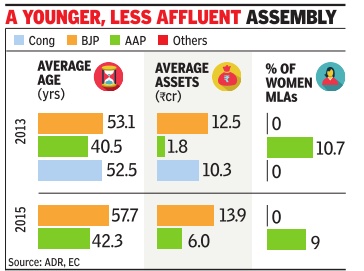
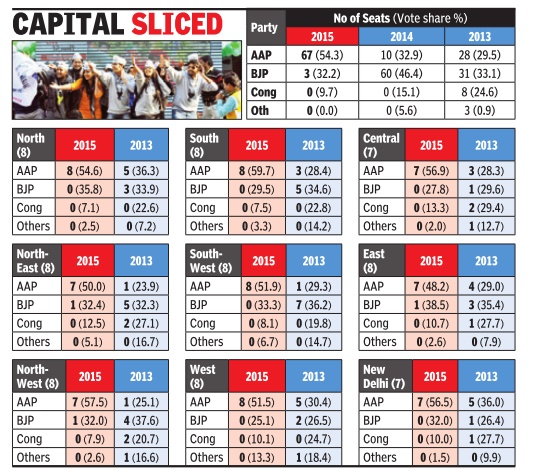
Feb 11 2015 Kejriwal and his team double their vote share
When a party raises its vote share from 29.5% to 54.3% from one election to the next, it cannot do so by improving in only some areas, but even so there are districts of Delhi where AAP's growth in the last 14 months has been more spectacular than in others. Its vote share in every district now is over 50% with the exception, ironically of the East district where it did so well last time. But even here, its share of 48% is nothing to sneeze at.
The truly stunning jumps have come in the South, North-West, North-East and Central districts. In each of these it has more than doubled its vote share from 2013, touching a dizzy 60% in South. In the process it has more than trebled its seat tally in these four districts from eight out of 31 in 2013 to 29 now.
For BJP , South and North-West districts will be most worrying because these are areas in which it's seen a sharp decline in vote share of five to six percentage points. In most other districts, its share is stable or little higher than last time. It is another matter that the collapse of the Congress vote as also those of `others' allowed AAP to gain so much that BJP lost many seats without any depletion in its kitty . Its share of 33.1% in a triangular race in 2013 was good enough to yield nearly half the seats, but the same vote share in an effectively straight fight proved woefully inadequate.
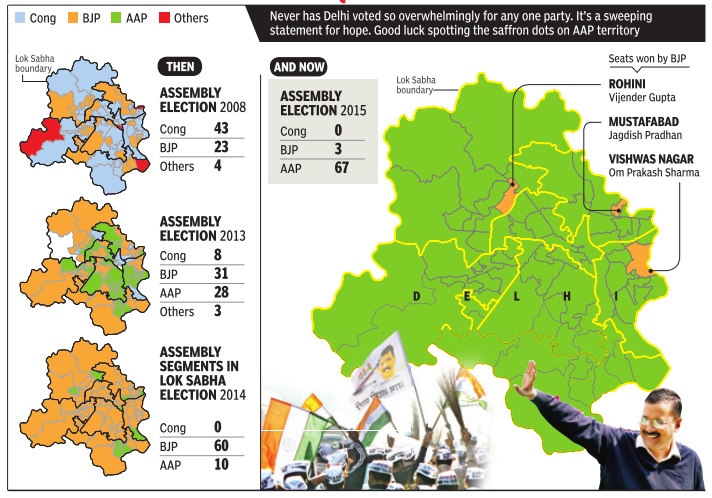
Muslims’ votes
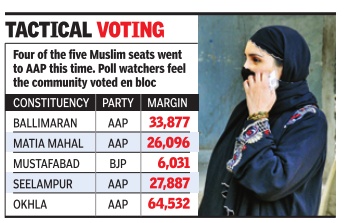
The Times of India Feb 11 2015
Minority report: Cong loses its traditional edge
The community , which had been Congress's face-saver in as many as five seats in the 2013 polls, seems to have abandoned it this time. Not all may have been convinced by AAP's promises, but it seems the community still voted en bloc for it, except in Mustafabad perhaps, where BJP's Jagdish Pradhan won. An AAP supporter reasoned, “Muslims in Mustafabad still voted for Congress, and BJP won only because of the split.“
The seat Congress was sure of winning was Matia Mahal where their candidate, Shoaib Iqbal, had never lost before.“Iqbal could've won on his own but joining Congress was a mistake. Moreover, Muslims this time had made up their mind to vote for AAP ,“ said Babuddin, a cook in the Jama Masjid area.
Corruption, poor living standards and inflation were the deciding factors for Muslim voters, the same as the rest of the city. But a spate of vitriolic speeches raised other con cerns. “There are leaders who keep fanning fear among Muslims. In fact, we are relieved AAP has won, as Congress did very little,“ said Naushad, a Walled City local.
In Okhla, Congress's Asif Mohammed Khan had won with a margin of 28,000 votes in 2013. This time, he finished third with just 20,135 votes.“There is a clear shift this time as our aspirations are the same as that of any other youth,“ said Aseem Ahmed of Zakir Nagar.
Voting pattern in reserved constituencies
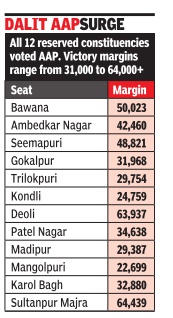
Feb 11 2015
AAP's victory in all 12 reserved seats shows how Arvind Kejriwal had won over Dalits in his 49-day rule with promises of free water, subsidized power and immunity from corruption. Even BJP's last-minute gamble to field Congress's old Dalit face, Krishna Tirath, flopped. He managed around 35,000 votes, less than half that of the AAP victor.“Tirath's gamble didn't work for the BJP and it helped us further,“ said an AAP leader.
Dalits had swung towards AAP in 2013 itself, giving Kejriwal 9 of the 12 seats.It's apparent he consolidated his support in the bastis during his brief rule by checking petty corruption.
BJP's dalit cell head Udit Raj said he had reported to the party brass a week ago that the Dalit vote was slipping from them. “I realized during election campaigning that dalit voters were following AAP ,“ he said. In 2008, nine seats went to Congress, one to BSP and two to BJP .
Many in BJP believe it was the symbol of the broom that worked magic for AAP .
2015: margin of victory
Feb 11 2015
In seat after seat, the gap just got wider
Disproving all assumptions of a close fight between BJP and AAP in most constituencies and triangular contests in many, the results have shown that AAP has not only swept the elections, it has done so comfortably with huge margins in most places. In 2013, the highest margin was over 48,500 while the average margin for all seats was a little under 10,000. In this election, there were seven constituencies which had higher margins than last time’s highest of 48,500 plus. The average margin is about 28,000, almost three times the 2013 average and there are 61 constituencies with higher margins than the 2013 average of almost 10,000.
There were 15 constituencies with margins of over 40,000 votes, all won by AAP.
Another 30 constituencies where margins ranged between 20,000 and 40,000 were also won by AAP. BJP’s first entry into a list of constituencies ranked by descending margin of votes would be at No. 60, indicating that there was a strong wave for AAP not spotted by election analysts or political parties.
AAP’s Mahinder Yadav got the highest margin of 77,665 in Vikaspuri over the BJP candidate. In Okhla, where Congress had won in 2013 with a margin of 26,545 over AAP, this time, AAP’s Amanatullah Khan won with a huge lead of more than 64,000 votes. In Kirari, the constituency with the highest margin in 2013, where BJP candidate Anil Jha had defeated AAP, the party has made an impressive comeback with its candidate Rituraj Govind defeating Jha with a lead of over 45,000 votes.
Interestingly, among the constituencies with the highest margins for AAP this time, six were won by BJP in the last election-Bawana, Matiala, Badarpur, Kirari, Karawal Nagar and Narela. Of the 15 highestmargin seats this time, all won by AAP, only six were won by AAP in 2013. Ironically, the lowest margins too were hogged by AAP. The lowest margin of this election was 1,555 in Najafgarh, where AAP’s Kailash Gahlot defeated the Congress in a nail-biting finish. In 2013 there were five constituencies where the margin was less than 1,000.
The results could have been an even bigger embarrassment for the BJP, which won by relatively narrow margins in two of the three seats they won. These two seats—Rohini and Mustafabad—are among only nine seats which saw margins of less than 10,000. The only seat that BJP retained from the last election was Vishwas Nagar, where Omprakash Sharma won by just over 10,000.


